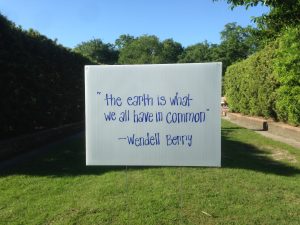Daniel Merhi — Wendell Berry | The Peace of Wild Things
1
Wendell Berry | The Peace of Wild Things
When despair for the world grows in me
and I wake in the night at the least sound
in fear of what my life and my children’s lives may be,
I go and lie down where the wood drake
rests in his beauty on the water, and the great heron feeds.
I come into the peace of wild things
who do not tax their lives with forethought
of grief. I come into the presence of still water.
And I feel above me the day-blind stars
waiting with their light. For a time
I rest in the grace of the world, and am free.
Section 1 | Preface & Introduction
My name is Daniel Merhi, and I’m analyzing Wendell Berry and his environmental poem, “The Peace of Wild Things.” I’m licensing my work under CC BY-NC-ND.

The Peace of Wild Things is a poem written by Wendell Berry regarding both the “solace & tranquility” of nature. It’s what appears to be a deviation of true peace, garnered through existing in the natural world. Wendell Berry’s poem embodies how despite the modernized world that continue to define our lives, the beauty and relic of nature isn’t bound by the industrial construct, but by its timelessness. While the art of poetry is open to interpretation, I found that Berry’s work is an example of how we–as humans–are morally and ethically responsible for the beauties of the world that are outside our circle of technology; for if we do not, we lose the forefront of peace that lies within. Berry’s writing offers the conjunction within social sciences and artistic literature; these being integral for the purpose of environmental consciousness.
Section 2 | Two Themes
I found that Berry’s poem envelops two great themes shared by environmental artists. The first theme (albeit more superficial) I noted was the “realism & connection with nature.” This theme envelops concepts such as biophilia (the love of life/living things). At the beginning of his poem, Berry writes an intimate–a personal struggle and fear that we all go through in life–the fear of the unknown. In the given context, it’s more-so about how life and its complexities are the realities that can be shunned by the solace of quiet solitude and presence in nature. Berry goes on in his poem with excellent visual imagery, noting how he spends time within the company of wild creatures, and how his worries slowly dissipate at the view of life’s simple vice.
That brings me to my next theme of the “presence within simplicity.” Throughout the poem, Berry writes about the experience with nature as a meditative (mindful) and transcendent way of life. The “day-blind stars waiting with their light” are indicative of the light in life we cannot see just yet; it requires a calm allowance of patience and time to understand that the prosperity and “good-will” of life are pertinent to all of us. Berry connects environmentalist ideologies of the beauties of natures with the ideologies of life itself. He finds peace through the animals’ inability to “tax…lives with forethought” and with the “presence of still water.” In essence, he contrasts the turmoil of life with the tranquility of nature.
Section 3 | Analysis


Wendell Berry is known as an American poet, writer, farmer, and environmental activist. He was born on August 5, 1934, Kentucky. Wendell’s most popular works are typically dealing with the interrelationship between nature, humans, and the impacts of industrialization on the environment; these being integral themes of environmental sociology and human psychology. The poem I chose was a representation of an appreciation of nature. While it wasn’t adamant on change and reformation, it did proclaim a common theme environmental activists & artists share–the love of the environment and detraction of industrialization. Wendell Berry wrote multiple poems directly arguing this, such as “The Unsettling of America,” & “What are People For.”
The images I picked are indicative of the Berry’s beliefs and occupations. The image on the left showcases Berry’s work and discussion in agriculture/land, and the image on the right is a direct quote by him, signifying that we are responsible for taking care of our home.
Section 4 | Application
While Wendell Berry may not have a prolific and direct declare for the need to change the current modern infrastructure, his work does however envelop intrinsic beauties of nature and life itself. The Peace of Wild Things aims for environmental consciousness; it can lead readers to living a more sustainable and environmentally supportive lifestyle. Berry is an environmental artist, but he doesn’t portray the work of his art through direct confliction of the rights and wrongs of human society. Rather, he paints the essence of nature—comparative to our often enclosure in technology and life-matters. He showcases how the simple vices of the world are a true suppressor of life’s worries—bound by our conspicuous complexities. The significance of his writing is to show, not tell. It’s about connecting the emotions and the quaintness of life with the reader, thus being the art that drives a more conscious mind towards love and affection of the natural world.

